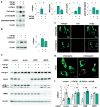Metformin reverses established lung fibrosis in a bleomycin model
- PMID: 29967351
- PMCID: PMC6081262
- DOI: 10.1038/s41591-018-0087-6
Metformin reverses established lung fibrosis in a bleomycin model
Erratum in
-
Author Correction: Metformin reverses established lung fibrosis in a bleomycin model.Nat Med. 2018 Oct;24(10):1627. doi: 10.1038/s41591-018-0170-z. Nat Med. 2018. PMID: 30104770
Abstract
Fibrosis is a pathological result of a dysfunctional repair response to tissue injury and occurs in a number of organs, including the lungs1. Cellular metabolism regulates tissue repair and remodelling responses to injury2-4. AMPK is a critical sensor of cellular bioenergetics and controls the switch from anabolic to catabolic metabolism5. However, the role of AMPK in fibrosis is not well understood. Here, we demonstrate that in humans with idiopathic pulmonary fibrosis (IPF) and in an experimental mouse model of lung fibrosis, AMPK activity is lower in fibrotic regions associated with metabolically active and apoptosis-resistant myofibroblasts. Pharmacological activation of AMPK in myofibroblasts from lungs of humans with IPF display lower fibrotic activity, along with enhanced mitochondrial biogenesis and normalization of sensitivity to apoptosis. In a bleomycin model of lung fibrosis in mice, metformin therapeutically accelerates the resolution of well-established fibrosis in an AMPK-dependent manner. These studies implicate deficient AMPK activation in non-resolving, pathologic fibrotic processes, and support a role for metformin (or other AMPK activators) to reverse established fibrosis by facilitating deactivation and apoptosis of myofibroblasts.
Conflict of interest statement
All authors declare no conflict of interest.
Figures




Comment in
-
Metformin: An Old Dog with a New Trick?Cell Metab. 2018 Sep 4;28(3):334-336. doi: 10.1016/j.cmet.2018.08.018. Cell Metab. 2018. PMID: 30184483
-
New Applications of Old Drugs as Novel Therapies in Idiopathic Pulmonary Fibrosis. Metformin, Hydroxychloroquine, and Thyroid Hormone.Am J Respir Crit Care Med. 2019 Jun 15;199(12):1561-1563. doi: 10.1164/rccm.201809-1700RR. Am J Respir Crit Care Med. 2019. PMID: 30822095 Free PMC article. No abstract available.
References
-
- O'Neill LA, Hardie DG. Metabolism of inflammation limited by AMPK and pseudo-starvation. Nature. 2013;493:346–355. - PubMed
Publication types
MeSH terms
Substances
Grants and funding
- P30 NS047466/NS/NINDS NIH HHS/United States
- P01 HL114470/HL/NHLBI NIH HHS/United States
- I01 BX003272/BX/BLRD VA/United States
- R01 AG046210/AG/NIA NIH HHS/United States
- P30 AG050886/AG/NIA NIH HHS/United States
- R01 HL139617/HL/NHLBI NIH HHS/United States
- T32 GM008361/GM/NIGMS NIH HHS/United States
- I01 BX003056/BX/BLRD VA/United States
- F30 HL136195/HL/NHLBI NIH HHS/United States
- R01 HL128502/HL/NHLBI NIH HHS/United States
- K08 HL135399/HL/NHLBI NIH HHS/United States
- R01 HL107585/HL/NHLBI NIH HHS/United States
LinkOut - more resources
Full Text Sources
Other Literature Sources

